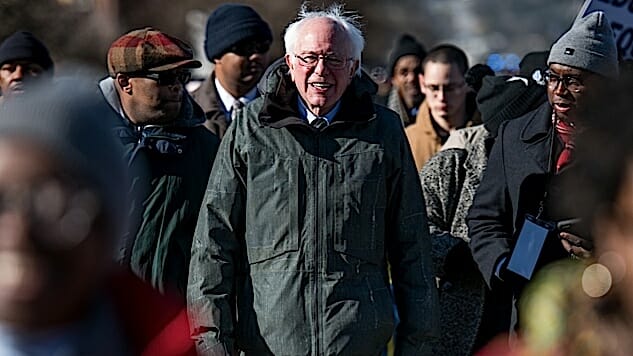For Bernie Sanders to Win, “Early State Momentum” Must Be Real
Photo courtesy of Getty
In 2016, Bernie Sanders came within a hair’s breadth of defeating Hillary Clinton in the closest Iowa caucus ever, and due to the vagaries of the caucus process, it’s entirely possible he won the pure vote count that the state Democratic Party declined to release. A week later in New Hampshire, he won 60.4% of the vote and trounced Clinton. It wasn’t quite the perfect start—he could have used that win in Iowa—but it was better than anything he could have envisioned in the anonymous days when he first announced his candidacy. But Nevada came next on Feb. 20, and he lost a close one by five points, and went on to get trounced in South Carolina where Clinton’s famous “firewall” first showed its potency. That was the last time Sanders was anywhere near a lead—Clinton won eight of 12 primaries on Super Tuesday, some of them by enormous margins…particularly in the American south, which made up half of that day’s races. From then on, Bernie didn’t have a mathematical chance to catch up, despite a big victory in Michigan that telegraphed Clinton’s eventual difficulties against Trump, followed by a favorable slate of late March states that saw him win in Wisconsin, Washington, and Utah, among others.
The point is, Sanders’ strength in Iowa and New Hampshire did not translate—there was no massive change in the momentum of the race, and once those states were over, they were well and truly over. Some have argued that a slim victory in Iowa, rather than a slim defeat, could have altered his fortunes, but it’s hard to see how that would have altered the hard reality of life in the south.
In 2020, things have changed a little. The superdelegates have been relegated to second-ballot relevance, and though the first four primaries remain the same, the Super Tuesday races are far more balanced, with states like California, Utah, and Maine now balancing out the overwhelming southern influence from 2016. Joe Biden as a primary opponent is also slightly less fearsome than Hillary Clinton, who had locked in the support of the party establishment so comprehensively that no traditional challenge was possible.
-

-

-

-

-

-

-

-

-

-

-

-

-

-

-

-

-

-

-

-

-

-

-

-

-

-

-

-

-

-

-

-

-

-

-

-

-

-

-

-








































